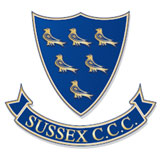A brief history of Sussex
Sam Collins with a brief history of Sussex CCC
Sam Collins
09-Oct-2006
|
|
 |
Formed 1839
First-class debut 1857
Admitted to Championship1890
County Championship 2001 (Div Two), 2003, 2006, 2007
Gillette/NatWest/C&G 1963, 1964, 1978, 1986, 2006
Benson & Hedges Best - Semi-finals 1982, 1999
Sunday League/Pro40 1982, 2005 (Div Two), 2008 (Div One)
Twenty20 Best - 2nd in Group 2003
Sussex can, with Kent, lay claim to being the birthplace of cricket. The first definite mention of cricket in Sussex is related to ecclesiastical records from 1611 which blame cricket for the non attendance at church on Easter Sunday by two parishioners of Sidlesham in West Sussex.
Regular matches took place throughout the 17th Century, but there was no formal organisation until June 1836, when the Sussex Cricket Fund to support county matches was set up after a meeting in Brighton. Sussex as we know them today were formed from this group on March 1 1839. They played their inaugural first-class match against MCC at Lord's in June 1839.
They won the unofficial Championship seven times and shared it once between 1826 and the formation of the County Championship in 1890. It would take them 113 years to win the Championship, but they challenged often in the early years under the captaincy of the great Australian Billy Murdoch and Kumar Ranjitsinhji, who passed 3000 runs in the Championship in both 1899 and 1900. Other great players from this pre-World War One era include the powerful allrounder Charles Fry and George Cox Senior.
The inter-war years saw batsmen of the calibre of the Langridge brothers, John and James, who passed 1000 runs in the season 37 times between them for the county, the legendary allrounder Maurice Tate and Kumar Duleepsinhji. Still the Championship eluded them, as they finished as runners-up for three years in succession between 1932 and 1934 under Tate's captaincy.
Things did not improve after World War Two and they again finished second in 1953 and fourth in 1955. By this stage the team was dominated by the runs of Jim Parks Junior, who passed 1000 runs for the season for 13 years in succession between 1953 and 1965. The 1960s gave rise to Ted Dexter who led a team containing Parks and the Nawab of Pataudi to victory in the first knock-out competition ever held by the counties in 1963. They won it again in 1964, but could not transfer this success to the longer game. The seventies saw the formation of an exciting new team featuring John Snow, Tony Greig, Garth LeRoux and Imran Khan. John Barclay almost led them to the Championship in 1981, but they had to be content with winning the Sunday League in 1982.
It would not be until 2003 that they finally ended their title quest, as Chris Adams' pugnacious leadership style united a team of few stars to fill the glaring space in their trophy cabinet, just three years after they had finished in last place. They made a mockery of their long wait for Championship success by winning it again in 2006, doing the double with the C&G Trophy. The impact of signing Mushtaq Ahmed, the Pakistani leg-spinner, in these two campaigns cannot be overstated. He took 103 wickets in 2003 and 102 in 2006, and his professionalism helped Adams to create a culture of success in the dressing-room. Other notable contributions in this period came from the batsmen Richard Montgomerie and Murray Goodwin, Matthew Prior and James Kirtley, who bowled the team to victory in the 2006 C&G final.
Sam Collins is a freelance journalist based in London